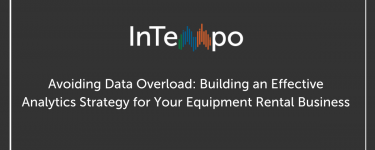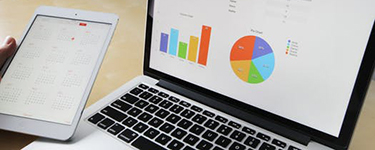Integrating Your Tech Stack: How to Make All Your Rental Software Programs Work Together Efficiently
As a rental business, you rely on technology to make your life easier. However: if you’re constantly entering the same information in multiple software programs or clicking back and forth from one application to another – are you really saving any time?
An average rental organization might use several dozen different software platforms. At InTempo, we’re big proponents of software that ties together rentals, sales, accounting, payments, maintenance, business intelligence, and other critical functions - but we also know that there are situations where third-party software brings additional functionality to the table. For instance, some of the rental organizations we work with use point solutions for:
- Parts procurement
- E-commerce
- Customer relationship management
As your tech stack gets larger, it becomes harder to keep all of your rental software programs working together. Your team may end up spending most of their time repeating the same manual process in multiple applications, leaving them with little time to focus on anything else. That’s where integrations enter the picture.

Building the Business Case for Integration
When a company outgrows their manual processes, it’s painfully obvious. If your employees are so bogged down with spreadsheets and manual daily processes that they don’t have time for higher-value work, integrations can deliver a meaningful ROI.
Getting your rental software programs to talk to each other behind the scenes gives your employees more time to help customers, analyze data, and make strategic decisions. This delivers more value to your business. It can ultimately cost more to pay employees to handle routine manual processes than it would cost to build an integration; that’s when you can more efficiently use your existing technologies to support your company’s growth.
An integrated tech stack doesn’t just help your back office. When you’re a local rental business that competes with the industry giants on customer service, it’s crucial to provide the best possible experience. That means faster responses, more availability, and more convenience. When a customer calls to reserve a specific machine, you need to do everything you can to get them that equipment in a timely manner; having the data you need when and where you need it makes it easier to provide that best-in-class experience.
Choose Your Primary Software System
When you’re integrating your tech stack – be it three applications or three dozen – you need to identify one primary system that serves as the foundation for everything else. In most cases, that’ll be your rental ERP, which can push and pull data to and from your other applications.
If you’re a smaller business that hasn’t adopted a rental ERP, you may want to choose your financial software as your source of truth. However, this will limit your ability to communicate with other platforms that use API or FTP services or file transfers. Ultimately, if you’re looking for a tech stack that can support future growth, you’ll need a foundation that can support specific rental processes and communicate with other technologies.
Identify Your Desired Outcome
When we work with a company that’s looking to integrate their rental tech stack, we encourage them to put the “why” before the “how.”
Are you trying to reserve equipment as soon as an order comes in so your counter staff doesn’t have to manually tell yard staff when to stage each machine for delivery? Are you trying to sync hour meter information with your work order solution to better plan for routine maintenance? Once you have a clear desired outcome, you can work backward on the technical requirements.

Determine How – And How Often – Data Should be Sent
If you’re running a rental ERP, your ERP can call APIs to pull data from your other software packages. Conversely, you can make your ERP’s APIs available to your point solutions to push data into your other software applications.
You can push or pull data on any schedule, depending on how quickly you need the information. For time-sensitive processes such as order fulfillment, you can have your systems sync in real time, or every few minutes. This keeps your workflows moving as quickly as possible.
For less time-sensitive items, you can schedule daily/nightly jobs. In most cases, a daily or nightly batch is the more efficient option, putting less strain on your IT infrastructure.
Consider Unique Rental Workflows
Many programmers can build an integration, but it’s helpful to work with a team that understands the ins and outs of the rental industry. Someone who has been through the process hundreds – if not thousands – of times and knows how other rental organizations are handling operations can be an invaluable resource.
This is another benefit of using a rental ERP as your primary system of record. Your ERP vendor may already have an interface with your other point solutions, which can save you from the trial-and-error of developing an integration from scratch.
Anecdotally: when InTempo first started integrating with SmartEquip, we wrote the system from scratch. Now, their software can call our API and access the data it needs. Customers can seamlessly transfer data back and forth between the two systems – and they don’t have to go through the time-consuming process of building a brand new integration.
Don’t Shy Away From Custom Development
Native integrations can save time, but that doesn’t mean you need to shy away from custom development.
Here as well, your rental software company can run interference on your behalf. Their developers can sit down with your other third-party software vendors and work through the technical details. What kind of information is the application creating? What service is it performing? Is the program using or calling APIs and what are the hooks? Do they want flat files or another format? With a detailed understanding of the process, it’s straightforward enough to create a plan and build the integration.

Choose a Project Lead with Operational Experience
As you integrate your rental tech stack, one point of contact should serve as your internal project lead. Although your inclination may be to choose someone from your IT department, it’s better to choose someone with a broader understanding of your business. A project lead with an operational mindset can answer initial questions about your policies, procedures, and hierarchies, then route other questions to the correct end users.
Get End-User Feedback During Testing
Software companies can make assumptions about how your processes work – but sometimes, those assumptions don’t translate to the reality of your business.
Once you’ve built your integration, allow end users to test the system and identify as many “holes” as possible. The people who will use the system every day will be best equipped to identify areas that don’t work the way they should. Similarly, asking their input before going live can help encourage adoption.
Train the Trainers
Once you’ve invested your resources into integrating your rental technologies, it’s crucial that end users not default back to “the way it’s always been done”.
At InTempo, we see the most success with a “train the trainers” approach. Our Professional Services team educates our customers’ higher-level employees, who in turn provide answers to their organization’s end users.
Future-Proofing Your Rental Tech Stack
One reason rental companies hesitate to dive in to an integration project? They don’t want to spend time – and money – connecting systems that won’t be around in three or five years.
To that end, that’s one of the biggest pieces of advice I’d offer to a company that’s trying to optimize their tech stack. Don’t just think about today; think about where you plan to go as you grow.
Before you start down the path of integrations, make sure you’re starting on the right foundation. Ideally, that’s a complete ERP system that supports all of your day-to-day operations as a rental business.
Once you have the right base platform to manage your financials, sales, rentals, and service, start thinking strategically about add-on pieces. Does adding an e-commerce website help you better meet your customers’ expectations for immediate reservations? Does investing in telematics give you the tools you need to more effectively monitor your fleet?
Lastly, consider your expected break-even point for an integration. When will it be more costly to have employees manually execute duplicate processes than to have your systems automate workflows on the back end? A successful integration can pay for itself quickly, in terms of both productivity and efficiency gains, but it doesn’t have to be the first thing on your to-do list. You can take the time to get used to a new application, then integrate it with your ERP once you know how you can best use it for the long haul.
Let InTempo Help You Integrate Your Rental Software Programs
At InTempo, we’re always up for a conversation. If you’re an existing customer, feel free to ask us how we can integrate with the software packages you are considering. There’s a good chance the answer is yes – and we’re happy to help you make an informed decision about the impact it can make on your business.
If you’re not an InTempo customer, we’re here to help you make sure you’ve got the right tools in place for long-term success. Feel free to contact our team with any rental software questions you may have.


